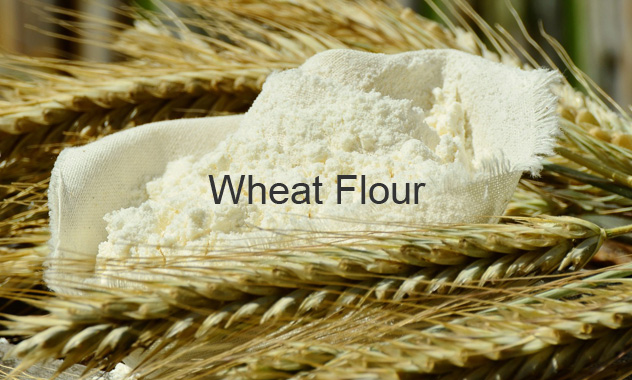Since we run a flour mill, we offer many and various types of flour. Here, let us introduce some of our most popular types of flour used for making noodles. If you are interested in some other types, please ask specifically and we'll get back to you.
Japanese Traditional Udon Noodles
Sanuki Suzuran (Lily)
-
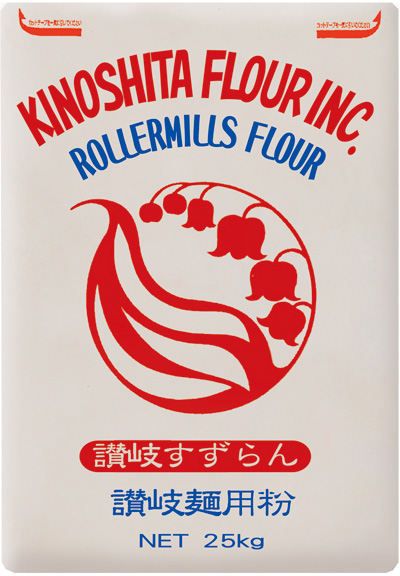
Typical Analysis
Use Purpose
Japanese Traditional Udon Noodles
Ash
0.34%
Gluten
28.5%
Protein
9.5%
Moisture
14.0±0.3%
- This is our most popular brand of noodle flour. Udon shop owners often say that they can smell the aroma of the wheat when they throw the Udon into boiling water. Udon made from fresh flour always smells fresh and we always provide fresh flour and the compact size of our mill gives us great flexibility to respond quickly to all requests.
The wheat kernel consists of 83% endosperm, 15% bran, and 2% germ. Wheat flour is made from the endosperm part of the kernel. The important thing is that the character of the endosperm differs, depending on which part of the kernel it is from. In other words, the endosperm which is close to the center of the kernel is creamy and soft, and tends to get darker and tougher the closer to the surface we go.
The endosperm used for Sanuki Suzuran is close to the center, and therefore it produces a nice colored and sweet-scented Udon with a soft and chewy texture. Udon made of Sanuki Suzuran has the following properties:
(1) It has a brilliant light-yellow color.
(2) It has an excellent elasticity and goes down very smoothly as we eat it.
(3) It does not have a simple hardness, but a chewy stickiness of true Sanuki Udon.
Chikuwa Tempura Udon (Udon with deep-fried fish paste)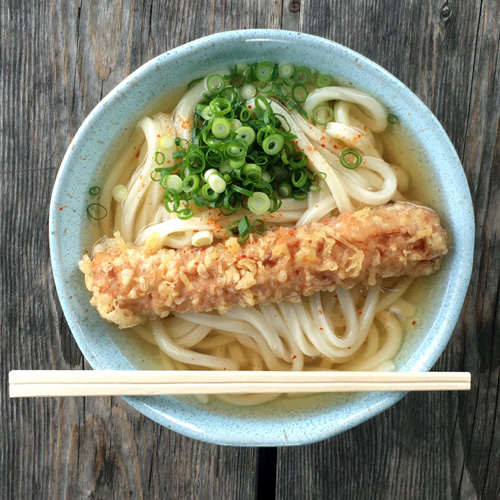
-

Typical Analysis
Use Purpose Japanese Traditional Udon Noodles Ash 0.34% Gluten 28.5% Protein 9.5% Moisture 14.0±0.3% - This is our most popular brand of noodle flour. Udon shop owners often say that they can smell the aroma of the wheat when they throw the Udon into boiling water. Udon made from fresh flour always smells fresh and we always provide fresh flour and the compact size of our mill gives us great flexibility to respond quickly to all requests.
The wheat kernel consists of 83% endosperm, 15% bran, and 2% germ. Wheat flour is made from the endosperm part of the kernel. The important thing is that the character of the endosperm differs, depending on which part of the kernel it is from. In other words, the endosperm which is close to the center of the kernel is creamy and soft, and tends to get darker and tougher the closer to the surface we go.
The endosperm used for Sanuki Suzuran is close to the center, and therefore it produces a nice colored and sweet-scented Udon with a soft and chewy texture. Udon made of Sanuki Suzuran has the following properties:
(1) It has a brilliant light-yellow color.
(2) It has an excellent elasticity and goes down very smoothly as we eat it.
(3) It does not have a simple hardness, but a chewy stickiness of true Sanuki Udon.
Chikuwa Tempura Udon (Udon with deep-fried fish paste)

Sakura Yume 2000 (Cherry 2000)
-
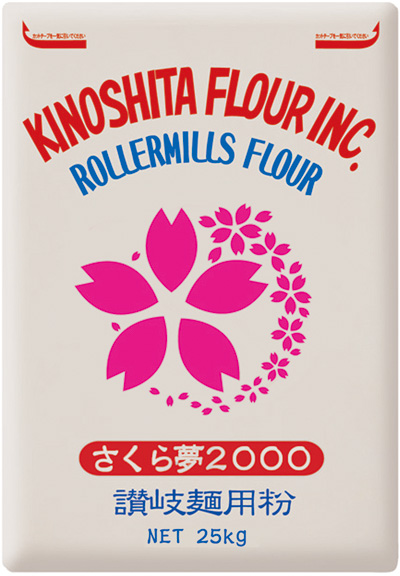
Typical Analysis
Use Purpose Japanese Traditional Udon Noodles Ash 0.34% Gluten 27.5% Protein 9.0% Moisture 14.0±0.3% - This is a blend of two flours; ASW (Australian Standard White) and Sanuki No Yume (Kagawa's own home grown wheat). ASW has a nice brilliant light-yellow color, goes down smoothly when we eat it, and a chewy stickiness, while Sanuki No Yume adds its own delicious taste. Thus Sakura Yume 2000 has both properties. Compared to Sanuki Suzuran, Sakura Yume 2000 produces a bit softer and more tasteful Udon.
Goboten Udon (Udon with deep-fried burdock)
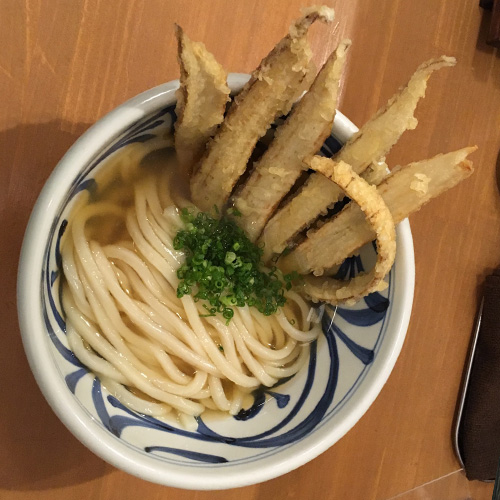
Shirobara (White Rose)
-
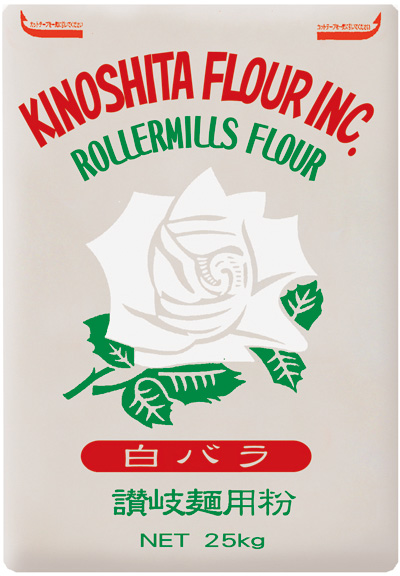
Typical Analysis
Use Purpose Japanese Traditional Udon Noodles Ash 0.37% Gluten 28.5% Protein 9.5% Moisture 14.0±0.3% - The Shirobara brand is the oldest of our noodle flours and has been sold for more than half a century. This is suitable not only for Teuchi Udon (Handmade Udon), but also for dried noodle or Somen (another type of thin Japanese traditional dried noodle good for summer). While Sanuki Suzuran provides modern refined Udon, Shirobara offers a simple and somewhat old fashioned type of Udon. Udon made from Shirobara has the following properties:
(1)It’s been used by local Udon shop owners for more than half a century.
(2)It has a delicious taste, which never makes us feel tired of eating it, even though we enjoy it on a daily basis.
(3)It has the strongest "Koshi", or chewy texture of all our Udon flours.Nasubi Tempura Udon (Udon with deep-fried eggplant)
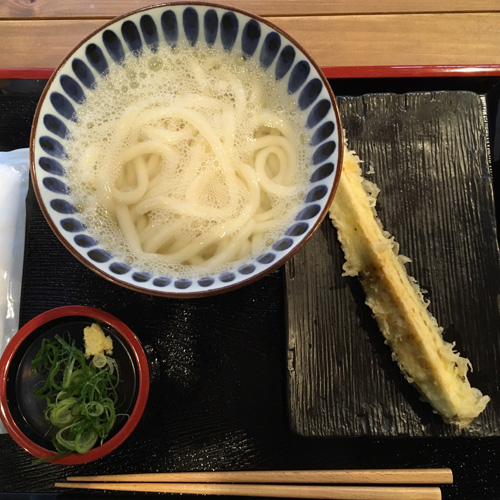
Sanuki No Yume (Sanuki's Dream)
-
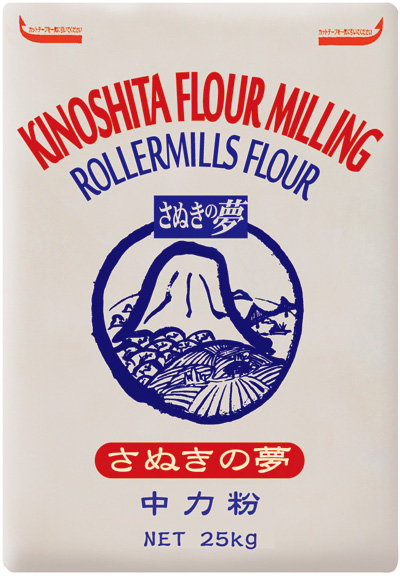
Typical Analysis
Use Purpose Japanese Traditional Udon Noodles Ash 0.34% Gluten 25.8% Protein 8.5% Moisture 14.0±0.3% - Sanuki No Yume is Kagawa’s original home grown wheat and this flour is 100% made from Sanuki No Yume. It offers the most chewy and tasteful Udon when properly processed. However, you need to be well trained and experienced to get full benefit of this flour. All wheat contains protein, or gluten, and the gluten content affects the working property when we make Udon. In other words, more gluten makes it easier to make Udon. The only weakness of Sanuki No Yume is the insufficiency of the gluten content. Anyone who makes Udon for the first time is advised to use Sanuki Suzuran. After becoming experienced with Sanuki Suzuran, one would be able to make a fine Teuchi Udon with Sanuki No Yume.
Shoyu Udon (Plain Udon with soy sauce)
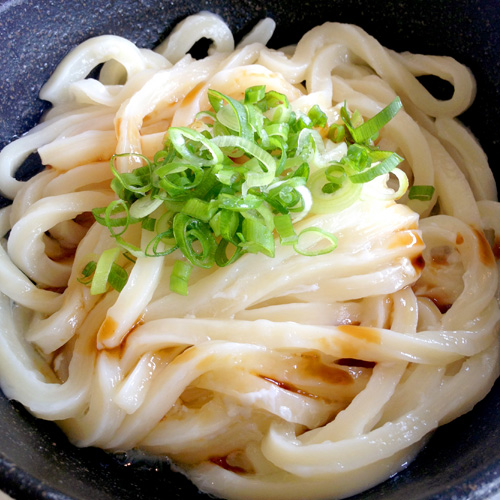
Sanuki Ichibanko (Sanuki #1)
-
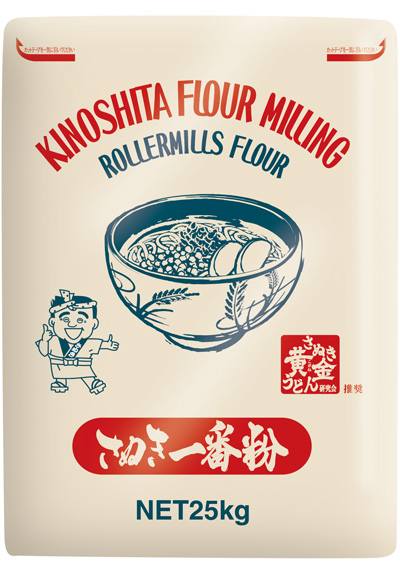
Typical Analysis
Use Purpose Japanese Traditional Udon Noodles Ash 0.33% Gluten 24.0% Protein 8.1% Moisture 14.0±0.3% - This is truly a new type of noodle flour. It’s not difficult to master the basic skills of Teuchi Udon, however, one needs to be trained at least for a couple years to do so. On the other hand, there might be someone who can’t afford to wait for that long. Then Sanuki Ichibanko could be a good choice because it’s so easy to handle and has some advantages as follows. These advantages have been made possible, thanks to adding tapioca starch to the mix.
(1)It has a quite unique chewy texture which other types of flour do not have.
(2)It cuts down cooking time by 20%.
(3)It retains its freshness longer than other flour after being cooked.Kake Udon (Hot Udon in broth topped with thinly sliced green onions)
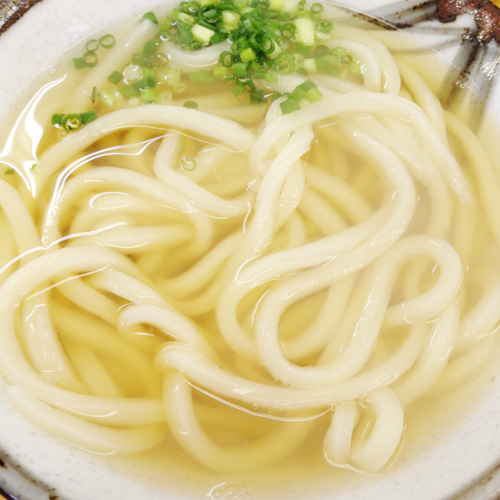
Ramen Noodles
Seiryu (Blue Dragon)
-
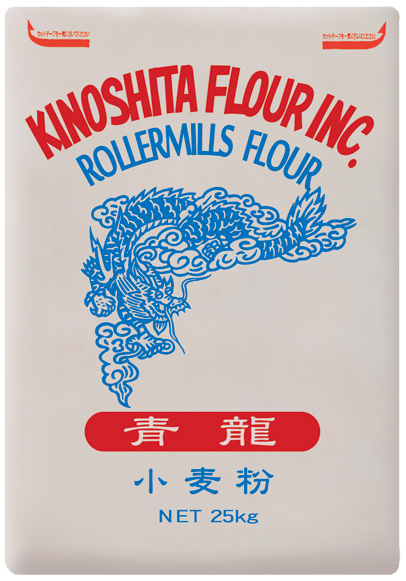
Typical Analysis
Use Purpose
Ramen Noodles, Wanton, Dumplings
Ash
0.34%
Gluten
31.0%
Protein
9.5%
Moisture
14.0±0.3%
- This is our most popular flour for Ramen noodles. Ramen noodles and Udon noodles are the same when it comes to noodles. That’s the reason why we can offer the best quality flour for Ramen Noodles.
One might want to emphasize that the chewy texture is important for Ramen Noodles. It is true; however, people would get tired of eating tasteless noodles no matter how chewy they are. In other words, taste and flavor of wheat are the true characteristics of excellent noodles. You never get tired of eating noodles if the noodle itself has a nice taste of the endosperm of wheat.
Blue Dragon offers Ramen noodles with a nice chewy texture, brilliant color, and most importantly subtle wheat flavor you never get tired of eating. Blue Dragon is suitable not only for Ramen Noodles, but also for Wonton or dumplings wrappers.
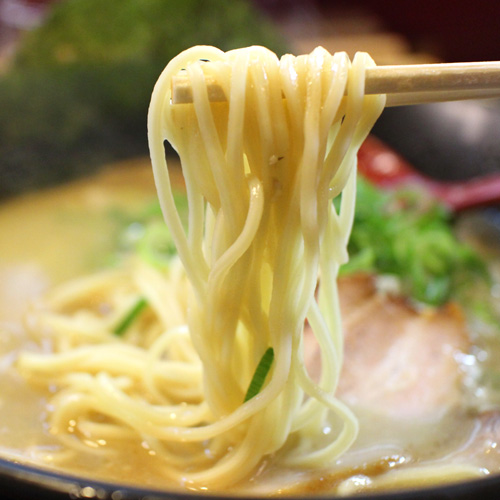
-

Typical Analysis
Use Purpose Ramen Noodles, Wanton, Dumplings Ash 0.34% Gluten 31.0% Protein 9.5% Moisture 14.0±0.3% - This is our most popular flour for Ramen noodles. Ramen noodles and Udon noodles are the same when it comes to noodles. That’s the reason why we can offer the best quality flour for Ramen Noodles.
One might want to emphasize that the chewy texture is important for Ramen Noodles. It is true; however, people would get tired of eating tasteless noodles no matter how chewy they are. In other words, taste and flavor of wheat are the true characteristics of excellent noodles. You never get tired of eating noodles if the noodle itself has a nice taste of the endosperm of wheat.
Blue Dragon offers Ramen noodles with a nice chewy texture, brilliant color, and most importantly subtle wheat flavor you never get tired of eating. Blue Dragon is suitable not only for Ramen Noodles, but also for Wonton or dumplings wrappers.

Flour for Binding Agent
Sekiryu (Red Dragon)
-
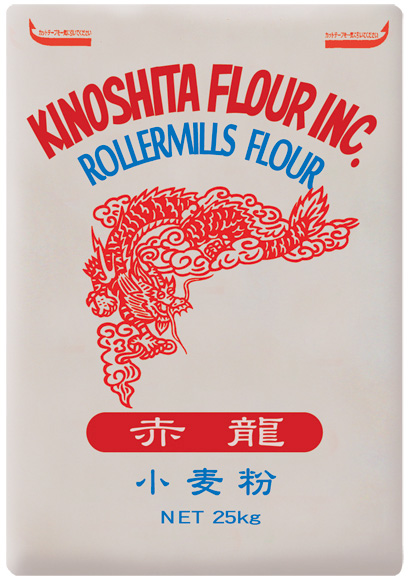
Typical Analysis
Use Purpose
Binding Agent for Soba
Ash
0.50%
Gluten
40.0%
Protein
13.5%
Moisture
14.0±0.3%
-
Soba is the Japanese traditional buckwheat noodle and it has several names, depending on how much wheat flour it contains. For example, Juwari Soba is made of 100% buckwheat flour, Nihachi Soba is made of 80% buckwheat and 20% of wheat flour, and Dowari Soba is made of 50% of each.
Since buckwheat flour doesn’t contain any gluten, it does not stick together well, so wheat flour is used as binding agent. In other words, the higher the ratio of wheat flour, the easier it is to make Soba. Then one might wonder how we can make Juwari Soba. In this special case, we use hot water to make dough instead of normal water, so that gelatinized starch can work as a binding agent. Akaryu (Red Dragon) would be a nice binding agent.
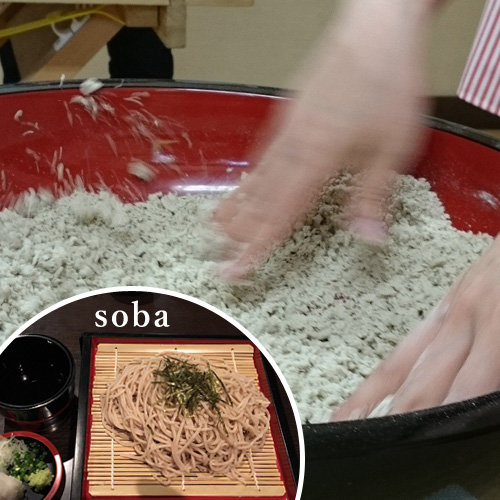
-

Typical Analysis
Use Purpose Binding Agent for Soba Ash 0.50% Gluten 40.0% Protein 13.5% Moisture 14.0±0.3% -
Soba is the Japanese traditional buckwheat noodle and it has several names, depending on how much wheat flour it contains. For example, Juwari Soba is made of 100% buckwheat flour, Nihachi Soba is made of 80% buckwheat and 20% of wheat flour, and Dowari Soba is made of 50% of each.
Since buckwheat flour doesn’t contain any gluten, it does not stick together well, so wheat flour is used as binding agent. In other words, the higher the ratio of wheat flour, the easier it is to make Soba. Then one might wonder how we can make Juwari Soba. In this special case, we use hot water to make dough instead of normal water, so that gelatinized starch can work as a binding agent. Akaryu (Red Dragon) would be a nice binding agent.



